Medical disclaimer: This article is for informational purposes only and does not replace professional veterinary advice. Always consult your veterinarian.
Table of Contents
Introduction
Diarrhea in dogs is one of the most common and stressful issues pet owners face. It can come on suddenly, make a big mess, and leave you wondering if your dog needs a vet visit. As a veterinarian practicing in Ottawa for over eight years, I’ve treated everything from mild dietary upsets to life-threatening cases like parvovirus. The good news is that many cases of dog diarrhea can be managed safely at home if you know what to look for.
In this guide, we’ll cover the most important things you need to know about dog diarrhea: when it’s safe to treat at home, what to feed your dog, and how to recognize signs that mean it’s time to call your vet. We’ll also walk through real-life cases from my clinic and provide a practical 5-minute checklist, cost expectations, and tips to prevent future digestive upsets. Whether you’re dealing with a one-off incident or a recurring issue, this guide will help you make informed and confident decisions for your dog’s health.
Key Takeaways
- Mild dog diarrhea can often be treated at home. Withholding food for 12 to 24 hours, then feeding a bland diet like boiled chicken and rice, can help ease symptoms.
- Probiotics and hydration are essential. Canine-specific probiotics and constant access to clean water support gut recovery.
- Watch for red flags. Signs like vomiting, lethargy, or blood in the stool mean it’s time to call your vet.
- Never give human medications. Drugs like Imodium or Pepto Bismol can be toxic to dogs.
- Prevention is key. A consistent diet, routine vet care, and avoiding garbage or table scraps can reduce the risk of future episodes.
Understanding Dog Diarrhea
Also visit: https://doglifeexpert.com/dental-disease-in-dogs-7-ways-to-releif-pain/
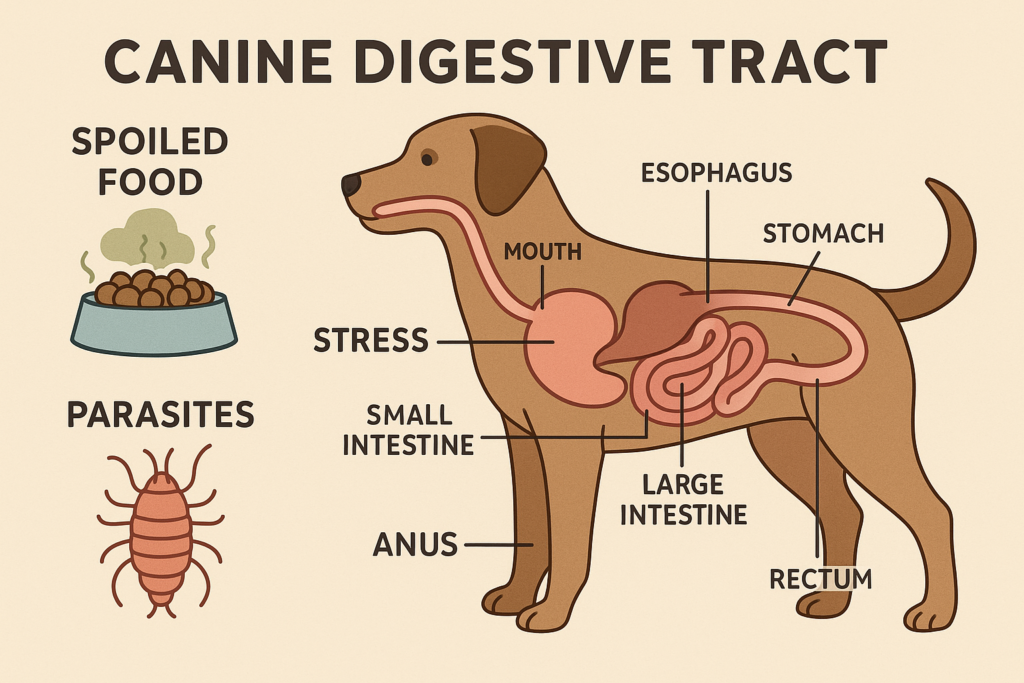
Dog diarrhea refers to loose or watery stools passed more frequently than usual. It is not a disease but a symptom that can range from mild to severe. As a veterinarian, I’ve seen cases triggered by something as simple as a change in dog food, to more alarming causes like parasites or toxins.
Common Causes of Dog Diarrhea
Understanding the underlying cause is the first step in choosing the right treatment. Here are some of the most frequent triggers I see in practice:
- Dietary indiscretion – Eating garbage, spoiled food, or non-food items like socks or toys
- Sudden diet changes – Transitioning foods too quickly without a gradual mix
- Stress – Events like boarding, travel, or a new pet at home
- Parasites – Roundworms, giardia, hookworms
- Viral infections – Especially parvovirus in puppies
- Bacterial infections – Such as salmonella or E. coli
- Toxins or medications – Human drugs, plants, or fatty foods
- Chronic illness – Conditions like pancreatitis, inflammatory bowel disease, or liver problems
Most episodes of dog diarrhea are acute and resolve within a couple of days, especially if the dog is still eating, drinking, and playful. But if symptoms persist, worsen, or are accompanied by other signs, professional care is essential.
5-Minute Home Assessment Checklist
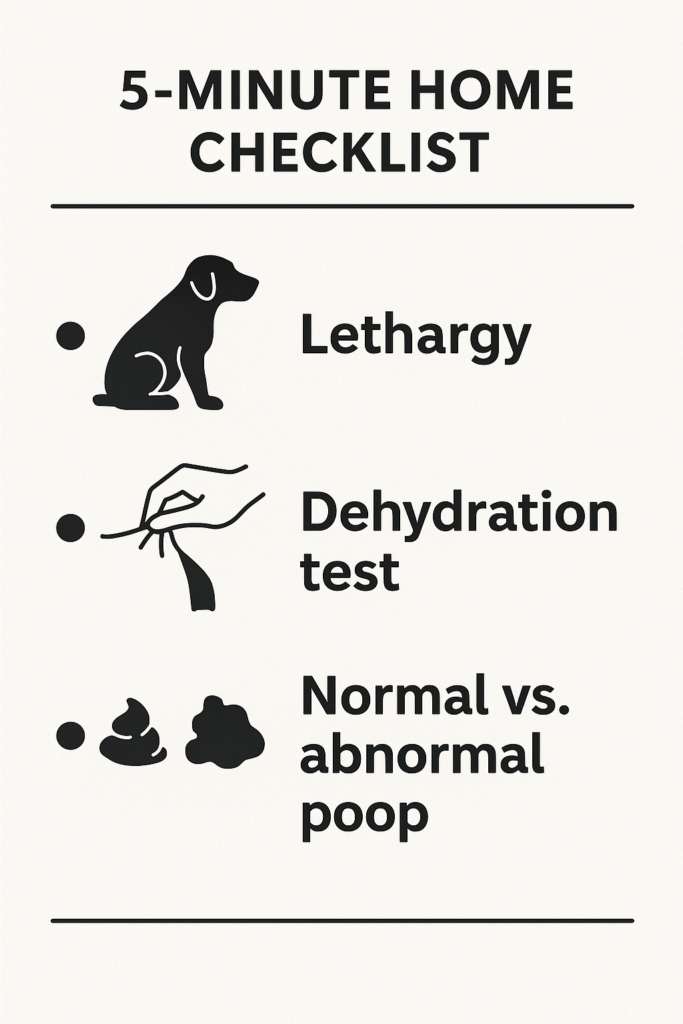
Before jumping into treatment, use this quick checklist to decide whether your dog’s diarrhea might be safe to treat at home or if you should contact your veterinarian right away.
| Check | What to Look For |
|---|---|
| Energy Level | Is your dog still alert, responsive, and playful? |
| Appetite | Will your dog eat treats or food? Or are they refusing everything? |
| Vomiting | No vomiting is a good sign. Vomiting + diarrhea is more serious. |
| Hydration | Gums should be moist and pink. Try the skin tent test to check for dehydration. |
| Blood in Stool | Bright red blood or black, tarry stool needs urgent vet care. |
| Duration | Has the diarrhea lasted less than 24 hours? |
| Age & Risk Factors | Puppies, seniors, or dogs with health conditions are at higher risk. |
If your dog passes this checklist with normal energy, no vomiting, and mild symptoms for less than a day, home care is often appropriate. However, always trust your instincts. If something feels “off,” call your vet.
Home Treatment for Mild Diarrhea
If your dog has mild dog diarrhea but is otherwise acting normal eating a bit, drinking water, and still wagging their tail you may be able to treat the issue at home. Here’s how to do it safely.
Step-by-Step Home Care
1. Withhold Food (Fasting)
- Skip food for 12 to 24 hours to let the gut rest.
- Always provide clean, fresh water.
- Do not fast puppies, small breeds, or diabetic dogs they can become hypoglycemic quickly.
2. Offer a Bland Diet
After the fasting period, feed small, frequent meals of easily digestible food:
- Boiled chicken (no skin or seasoning) and plain white rice
- Lean ground turkey with mashed potato
- Boiled hamburger and plain rice
Start with small portions (1–2 tablespoons for small dogs, ¼ cup for large dogs) every 3–4 hours.
3. Add Dog-Specific Probiotics
Probiotics help restore healthy gut bacteria. Look for products like:
- Purina FortiFlora (widely recommended)
- VetriScience Probiotic Everyday
- Zesty Paws Probiotic Bites
Follow package directions and consult your vet for dosage help.
Helpful Home Additions
Alongside bland food and rest, a few mild, dog-safe additions can help soothe your dog’s digestive system and support recovery from dog diarrhea.
- Plain pumpkin (unsweetened) – A rich source of soluble fiber that can help firm up loose stools.
- Natural yogurt (plain, low-fat) – Contains live cultures (probiotics) that may help restore gut balance.
- Boiled potatoes (no skin) – Gentle on the stomach and a safe source of energy.
- Cottage cheese or scrambled egg (no oil) – Offer in small amounts; useful if your dog isn’t keen on rice.
Use these only if your dog has had them before without a problem. When trying anything new during an episode of dog diarrhea, proceed slowly and watch for any worsening of symptoms.
What to Monitor
During home treatment, closely monitor:
- Stool frequency and consistency
- Energy level and behavior
- Appetite and willingness to drink
- Signs of dehydration (e.g., dry gums, skin tenting, sunken eyes)
If dog diarrhea does not improve within 48 hours or gets worse, it’s time to consult your veterinarian.
When to See a Veterinarian
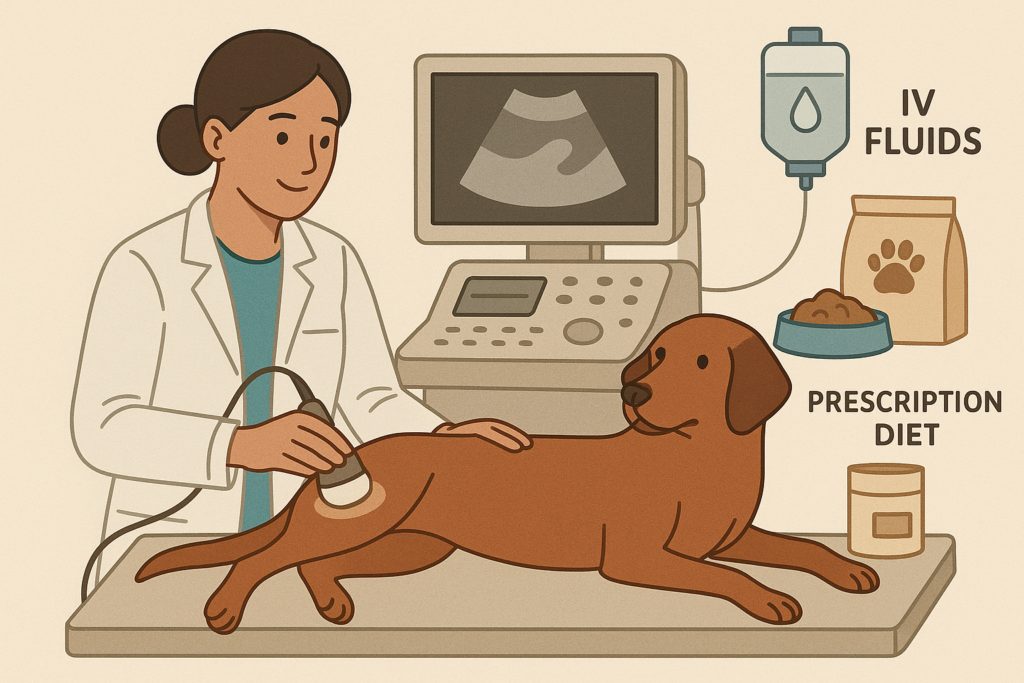
Some cases of dog diarrhea require more than home care. It’s important to recognize when symptoms indicate something more serious.
Warning Signs That Require a Vet Visit
| Symptom | Why It’s Serious |
|---|---|
| Vomiting + Diarrhea | Risk of dehydration and electrolyte imbalance |
| Lethargy or Weakness | Could indicate systemic illness or toxicity |
| Bloody Stool (Red or Black) | May signal intestinal bleeding, parvovirus, or ulcers |
| Diarrhea > 48 Hours | Ongoing diarrhea may point to infection, inflammation, or metabolic disease |
| Straining or Pain | Could suggest colitis, blockage, or a foreign object |
| Loss of Appetite | Often the first sign of deeper illness |
| Pale Gums or Sunken Eyes | Signs of dehydration or shock |
Dogs at Higher Risk
Dogs who fall into these categories should be seen earlier, even for mild dog diarrhea:
- Puppies under 6 months, especially if unvaccinated
- Senior dogs (over 8 years old)
- Dogs with chronic conditions like diabetes, kidney, or liver disease
- Small and toy breeds who dehydrate faster
If in doubt, don’t wait call your vet and, if you can, bring a fresh stool sample for testing.
Veterinary Diagnosis & Treatment
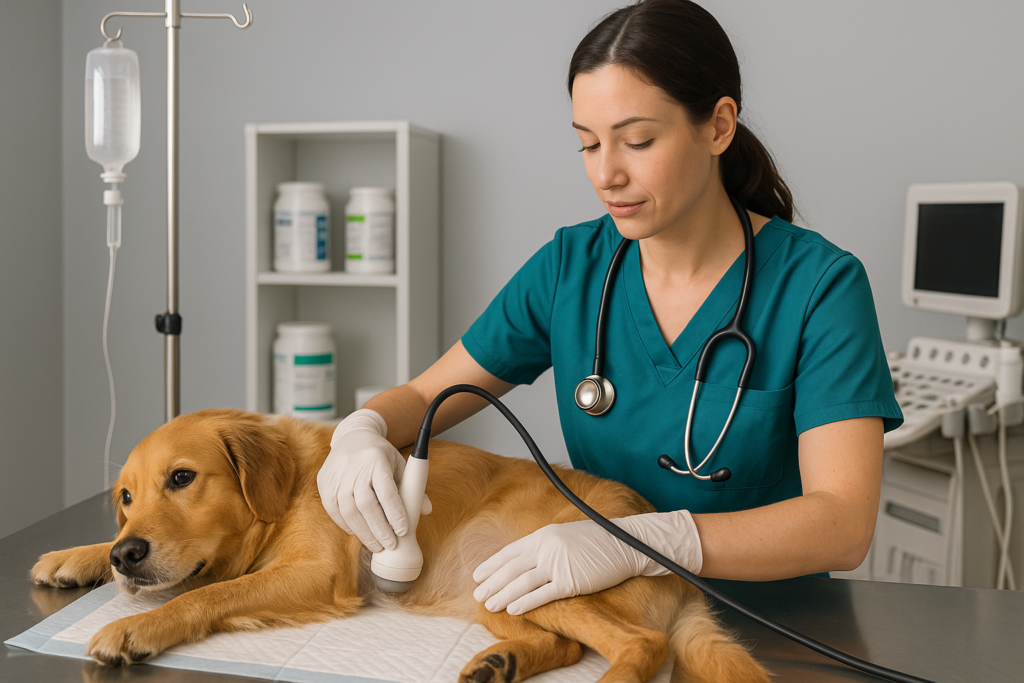
When home treatment fails or red flags are present, your vet will work to determine the cause of dog diarrhea and provide targeted treatment.
Common Diagnostic Tools
- Fecal Testing – Detects parasites like giardia, hookworms, or whipworms
- Blood Work – Screens for infections, inflammation, pancreatitis, or organ dysfunction
- Imaging (X-rays or Ultrasound) – Identifies obstructions, foreign bodies, or abnormalities
- Parvo Test – Crucial for puppies with vomiting and bloody diarrhea
- Endoscopy or Biopsy – Used in chronic or complex cases to assess the intestinal lining
Treatment Options
Based on the findings, treatments may include:
- Deworming medications – To eliminate intestinal parasites
- Antibiotics – For confirmed bacterial infections (used selectively)
- Anti-nausea and GI-protective drugs – Such as maropitant or famotidine
- Fluid therapy – To rehydrate and support recovery
- Prescription gastrointestinal diets – Like Hill’s i/d or Royal Canin GI
- Canine probiotics – To replenish healthy gut bacteria
- Hospitalization – In severe cases involving dehydration, bleeding, or systemic disease
By identifying the root cause early, your veterinarian can stop dog diarrhea from progressing into a more serious health crisis
Typical Canadian Cost Table
| Service | Estimated Cost (CAD) |
|---|---|
| Vet Exam | $80 – $130 |
| Fecal Test | $40 – $90 |
| Blood Work | $120 – $250 |
| X-ray or Ultrasound | $150 – $400 |
| Parvo Treatment (Hospitalization) | $1000 – $2500+ |
| Prescription Diet (Gastro Food) | $40 – $90 (per bag/case) |
| Probiotics (1-month supply) | $25 – $60 |
Pet insurance may cover part or all of these costs, depending on your policy.
Prevention Tips
Preventing dog diarrhea is easier than managing it once it starts. Many cases I see could be avoided with a few routine steps and some extra vigilance at home.
Keep Your Dog’s Diet Consistent
One of the most preventable causes of dog diarrhea is sudden changes in diet or feeding habits. Dogs have sensitive digestive systems that thrive on routine. Abrupt shifts or inconsistency can easily trigger gastrointestinal upset.
Choose a High-Quality Diet
Select a complete and balanced dog food that suits your pet’s age, size, and health needs. Look for foods that:
- List real meat as the first ingredient
- Avoid fillers like corn, soy, or artificial dyes
- Have been tested using AAFCO feeding trials
Stick with the same brand and formula unless advised by your vet to switch.
Transition Slowly When Changing Food
If a diet change is necessary due to allergies, health conditions, or availability transition gradually over 7 to 10 days:
- Days 1–2: 75% old food, 25% new food
- Days 3–4: 50% old food, 50% new food
- Days 5–6: 25% old food, 75% new food
- Day 7 onward: 100% new food
This helps your dog’s gut adjust and reduces the risk of diarrhea or gas.
Avoid Table Scraps and High-Fat Treats
Human food is a common culprit in cases of dog diarrhea I see. Fatty foods, rich sauces, and bones can lead to digestive upset or even serious conditions like pancreatitis.
- Skip leftovers: Dogs don’t need pizza crust, gravy, or chicken skin.
- Watch for hidden dangers: Foods like onions, garlic, chocolate, grapes, and xylitol are toxic to dogs.
- Limit treats: Keep treats to no more than 10% of your dog’s daily calories and choose simple, single-ingredient options.
If you want to offer variety, talk to your vet about safe toppers like plain canned pumpkin, green beans, or unsalted bone broth.
Consistency and simplicity in your dog’s diet go a long way toward preventing unnecessary bouts of dog diarrhea.
Prevent Garbage Raids and Foreign Object Ingestion
- Use dog-proof trash cans and keep dangerous items like bones, chocolate, or spoiled food out of reach.
- Be cautious during walks and at parks where dogs might scavenge.
Maintain Regular Vet Care
- Annual check-ups help catch digestive disorders early.
- Stay current with deworming schedules and vaccines (especially parvo for puppies).
- Discuss chronic or recurring dog diarrhea with your vet to rule out underlying disease.
Minimize Stress
- Dogs with anxiety are more prone to gastrointestinal upsets.
- Try to keep a consistent routine and use positive reinforcement during changes like travel or new family members.
Clean Up Promptly
- Dispose of feces regularly to reduce environmental contamination and parasite spread.
- Wash bowls daily and sanitize any messes indoors with pet-safe cleaners.
Practicing these simple preventive habits will reduce your dog’s chances of digestive trouble and improve their overall well-being.
Real Vet Cases From My Practice)
As a practicing veterinarian in Ottawa, I’ve seen hundreds of dog diarrhea cases. These three examples show how important it is to assess the full picture symptoms, age, and behavior before deciding whether to treat at home or seek emergency care.
https://www.akc.org/expert-advice/health/dog-diarrhea-causes-treatment
Case 1: The Table Scrap Trouble
Patient: 3-year-old Labrador Retriever
Cause: Dietary indiscretion
Story: After a weekend of sneaking fatty leftovers at a family BBQ, this Lab developed watery stools and mild gassiness.
Action: The owner fasted him for 12 hours, offered boiled chicken and rice, and added a probiotic.
Outcome: Resolved within 36 hours with no vet visit needed.
Case 2: A Puppy with Parvo
Patient: 9-week-old unvaccinated mixed breed
Cause: Canine parvovirus
Story: The puppy presented with bloody diarrhea, vomiting, and lethargy. A rapid parvo test confirmed the diagnosis.
Action: Immediate hospitalization, IV fluids, antibiotics, and isolation protocols.
Outcome: After four days of intensive care, the puppy recovered and started vaccinations.
Case 3: Foreign Object Emergency
Patient: 6-year-old Shih Tzu
Cause: Ingested toy part
Story: The dog had diarrhea with straining, then stopped producing stool and became lethargic.
Action: X-rays confirmed a blockage. Surgery removed a plastic squeaker lodged in the intestine.
Outcome: Recovered fully after surgery and supportive care.
These cases highlight that dog diarrhea may be mild and manageable or a sign of something life-threatening. Always err on the side of caution.
FAQs About Dog Diarrhea
1. Can I give my dog Imodium or Pepto Bismol?
No. Human anti-diarrheal medications like Imodium (loperamide) and Pepto Bismol (bismuth subsalicylate) can be dangerous for dogs. They may cause toxicity or hide symptoms of a serious problem. Only give medications if specifically prescribed by your vet.
2. What if my dog has diarrhea but seems fine?
If your dog has dog diarrhea but is eating, drinking, and playful, you can usually start with home care. Monitor closely. If diarrhea lasts more than 48 hours or worsens, call your vet.
3. How long should I try home treatment?
Try home care for 24 to 48 hours in mild cases. If there’s no improvement or if your dog starts vomiting, becomes lethargic, or stops eating, seek veterinary advice right away.
4. Is blood in dog poop an emergency?
Yes. Blood in the stool whether bright red or black and tarry can indicate serious issues like hemorrhagic gastroenteritis, parvovirus, or internal bleeding. Call your vet immediately.
5. What can I feed a dog with diarrhea?
Offer bland foods like:
- Boiled chicken with plain rice
- Ground turkey with mashed potato
- Boiled lean beef with plain pasta
Avoid treats, high-fat foods, or table scraps during recovery.
Summary Table: Treatment by Severity
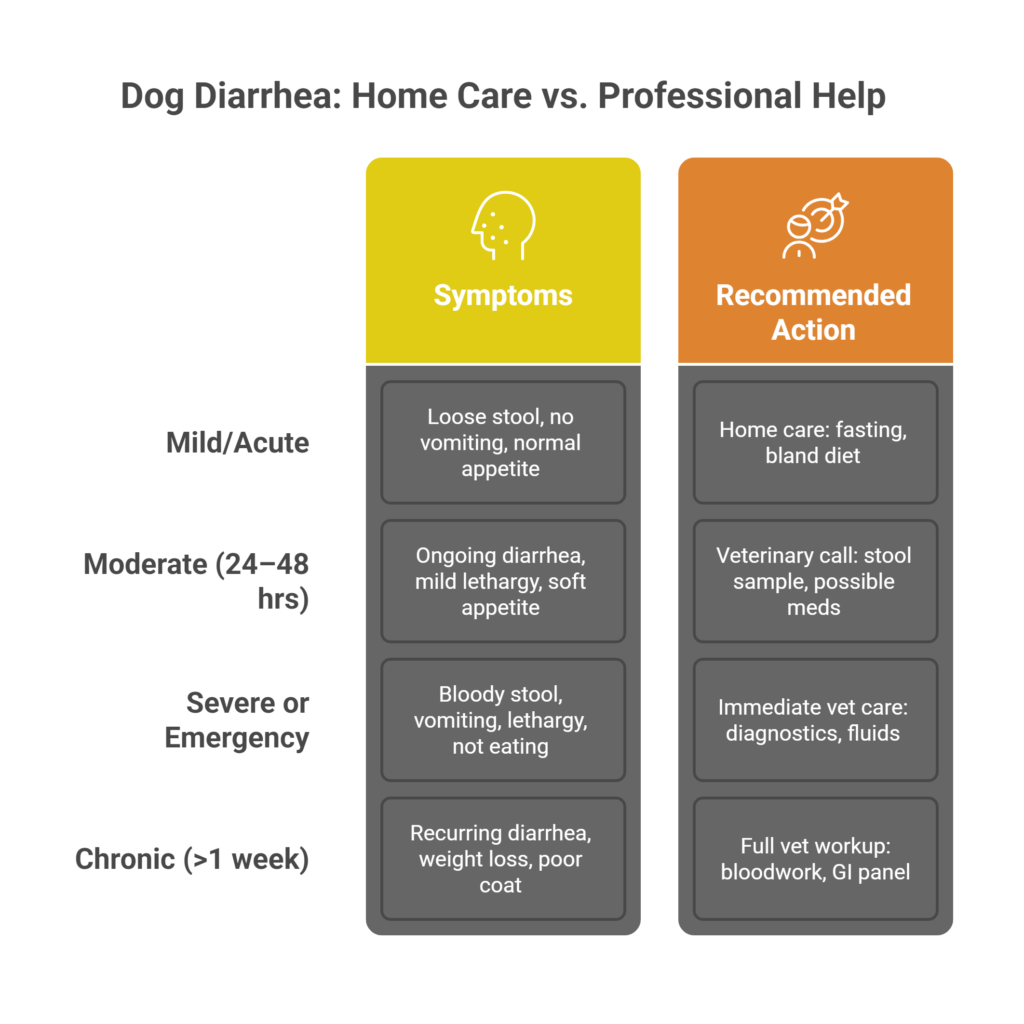
When in doubt, always contact your veterinarian especially if your dog is very young, elderly, or has underlying health conditions.
Conclusion
Dog diarrhea is one of the most common yet often misunderstood issues pet owners face. While mild cases can usually be treated at home with rest, a bland diet, and supportive care like probiotics, it’s crucial to know when a simple upset turns into something more serious.
As a veterinarian, I’ve seen firsthand how quick action and proper treatment can make all the difference especially in puppies, senior dogs, or those with chronic illness. The key is observation and understanding your dog’s normal behavior. If anything feels “off,” don’t wait to call your vet.
By following preventive steps like consistent feeding, avoiding garbage or table scraps, and keeping up with regular checkups and vaccines, you can drastically reduce your dog’s chances of developing digestive problems in the future.
Whether your dog is bouncing back after eating something questionable or you’re dealing with something more serious, you’re now better equipped to respond confidently, compassionately, and quickly.

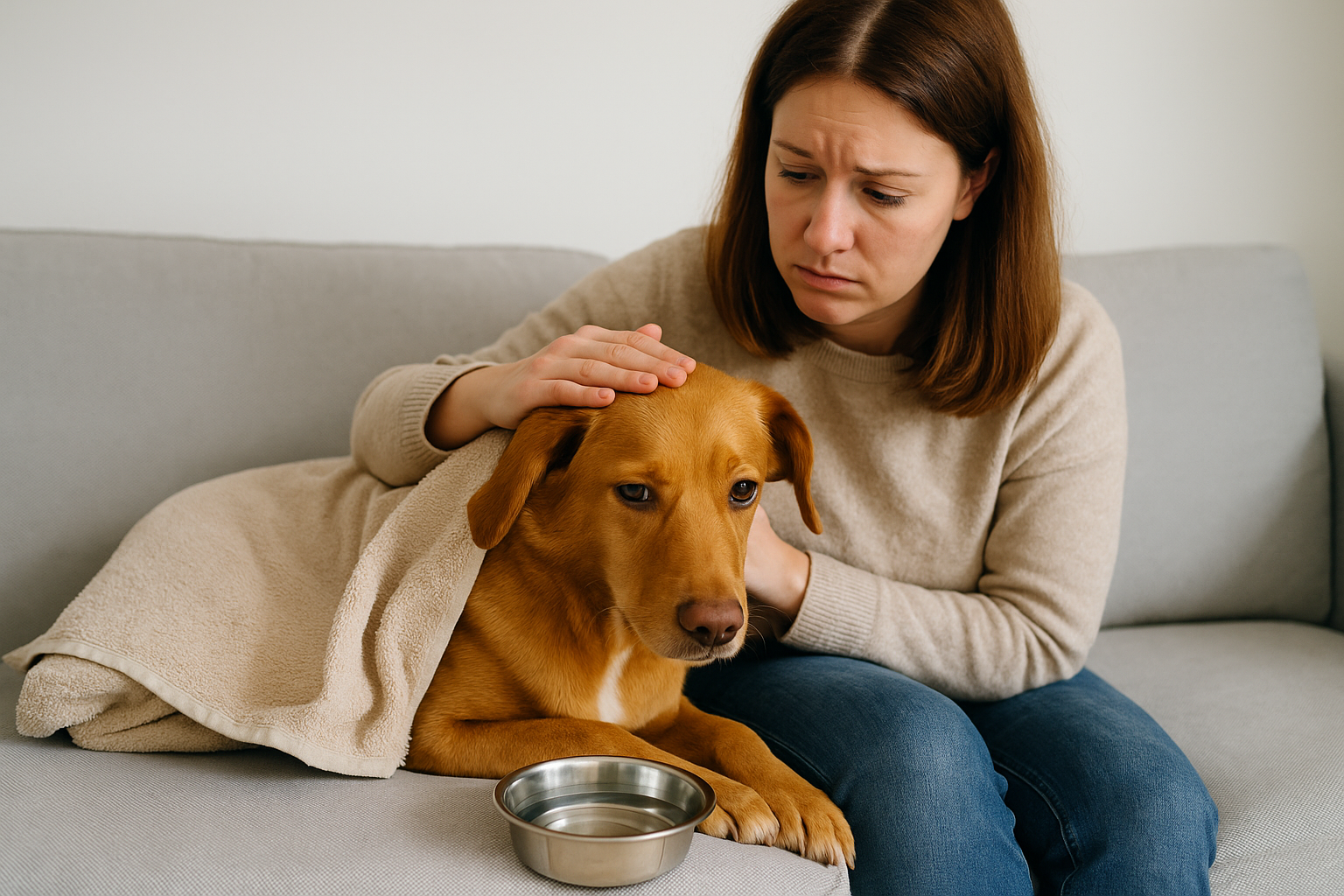
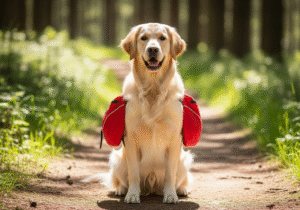
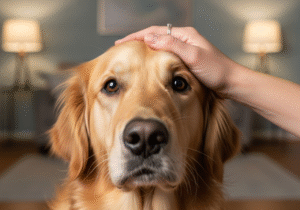
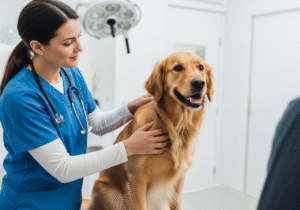
Pingback: "Top 10 Basic Dog Acupuncture Points: Canine Acupuncture Chart & Healing Guide"
Pingback: Can Dogs Eat Mango? A Canadian Vet’s Safe Feeding Guide 2025